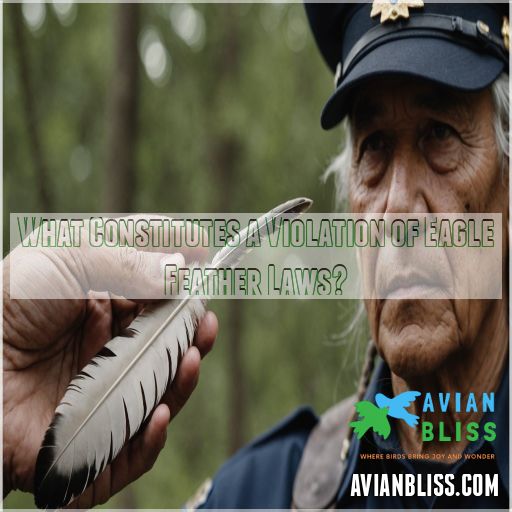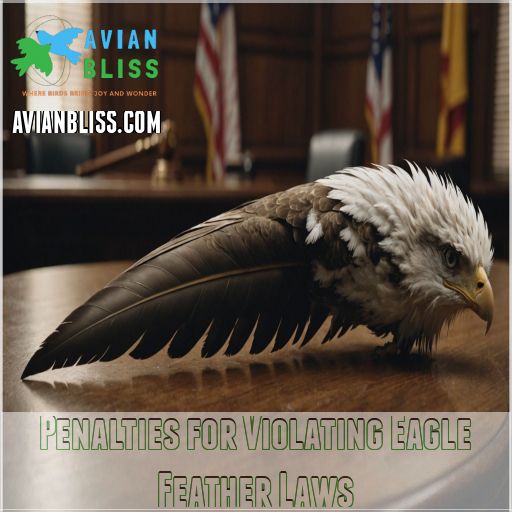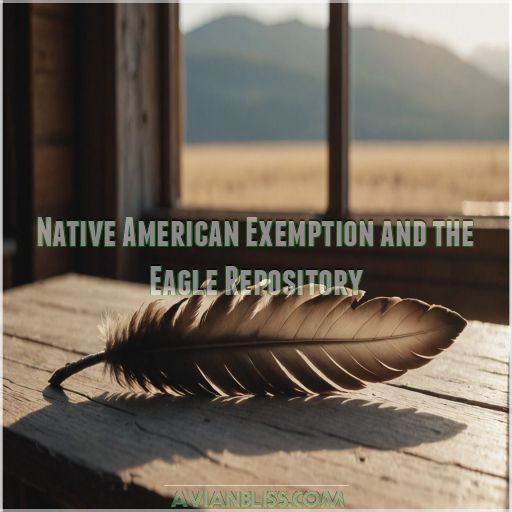This site is supported by our readers. We may earn a commission, at no cost to you, if you purchase through links.

You might think that a feather on the ground is a free souvenir, but federal laws say otherwise!
These strict rules stem from the Bald and Golden Eagle Protection Act and the Migratory Bird Treaty Act, aiming to make sure eagles don’t become as scarce as hen’s teeth.
Only Native Americans from federally recognized tribes can legally use eagle feathers for cultural and religious purposes, making sure balance between tradition and conservation.
Curious about how these laws evolved? Keep reading!
Table Of Contents
- Key Takeaways
- History of Eagle Feather Laws
- Why Are Eagle Feathers Protected?
- What Constitutes a Violation of Eagle Feather Laws?
- Penalties for Violating Eagle Feather Laws
- Native American Exemption and the Eagle Repository
- Debate and Impact of Feather Laws
- Wind Turbines and Eagle Populations
- Enforcing Feather Laws and Conservation Efforts
- Wisconsin State Laws and Regulations
- Reforms and Future Directions for Feather Laws
- Frequently Asked Questions (FAQs)
- Conclusion
Key Takeaways
- You might think picking up an eagle feather is harmless, but it’s as illegal as wearing mismatched socks to a formal dinner! U.S. laws protect these birds to ensure their populations thrive, and keeping feathers without a permit can land you in hot water.
- Wondering why these laws exist? They stem from the Bald and Golden Eagle Protection Act and the Migratory Bird Treaty Act, aiming to conserve these magnificent birds for future generations. So, just admire that feather and let the eagles keep their plumage.
- There’s an exception for Native Americans from federally recognized tribes. They can legally use eagle feathers for religious and cultural purposes, maintaining a delicate balance between tradition and conservation.
- Spot an eagle feather and tempted to pocket it? Resist that urge! It’s best to flutter away like a wise owl and leave it be, or you might end up learning firsthand how serious those fines and potential jail time can be.
History of Eagle Feather Laws
You’d think picking up a feather wouldn’t cause a flap, but eagle feather laws could land you in a legal nest if you’re not careful.
These laws have hatched from the Bald and Golden Eagle Protection Act of 1940 and the Migratory Bird Treaty Act of 1918, designed to make sure these majestic birds can soar for generations.
The Bald and Golden Eagle Protection Act
Under the Bald and Golden Eagle Protection Act, eagle feather possession is a no-go, like taking candy from a bald eagle. Remember these:
- Eagle Conservation.
- Eagle Permits.
- Eagle Habitat.
- Eagle Recovery.
Protect those majestic birds!
The Migratory Bird Treaty Act
The Migratory Bird Treaty Act of 1918 makes it a federal crime to possess any part of a migratory bird, including eagle feathers. Even found feathers must be left undisturbed to protect these endangered species.
| Migratory Bird Treaty Act | Protects | Penalties |
|---|---|---|
| Prohibits possession of any migratory bird part | Almost all birds except house sparrows, starlings, and pigeons | Up to 1 year in prison and $5,000 fine |
Evolution of Feather Laws Over Time
As regulations and public opinion have evolved, the eagle feather laws changed to adapt to new challenges.
Initially focused on bald eagles, laws expanded, even impacting owl feathers while balancing conservation with exemptions for religious purposes.
Why Are Eagle Feathers Protected?
You might think an eagle feather is just another feather, but it’s actually a big deal for conservation.
Protecting eagle feathers is all about preserving these magnificent birds and ensuring their survival for future generations.
Importance of Eagle Conservation
Learn about eagle conservation to understand why eagle feathers are protected.
It’s a team effort battling habitat loss and climate change.
Through partnerships and public education, we safeguard these majestic creatures, aiding eagle population trends—and that’s empowering!
Threats to Eagle Populations
Bald and golden eagles face numerous threats, including habitat loss, climate change, pesticides, pollution, and the growing menace of wind turbines. These dangers jeopardize their survival, making eagle feather protection essential.
- Habitat Loss: Deforestation and urban development destroy nesting sites and feeding grounds.
- Climate Change: Shifting weather patterns disrupt breeding cycles and food sources.
- Pesticides and Pollution: Toxins accumulate in the food chain, harming eagle health.
- Wind Turbines: Collisions and displacement from turbines take a heavy toll on eagle populations.
Role of Feather Laws in Conservation
Protecting eagles by outlawing feather trade is really important to their survival. These laws, though sometimes tricky to enforce, raise public awareness and inspire alternative protection methods to help these magnificent birds thrive in the future.
Protecting eagles by outlawing feather trade is really important to their survival. These laws, though sometimes tricky to enforce, raise public awareness and inspire alternative protection methods to help these magnificent birds thrive in the future.
| Impact | Description |
|---|---|
| Conservation | Preserves eagle populations |
| Awareness | Educates public about eagle protection |
| Deterrence | Prevents illegal trade and disturbances |
| Freedom | Ensures eagles thrive in natural habitats |
What Constitutes a Violation of Eagle Feather Laws?
Regarding eagle feather laws, one wrong move can land you in hot water, so it’s good to know the rules!
If you’re thinking about picking up a feather, you might want to think twice because even unintentional possession can lead to serious consequences.
Possession, Sale, Purchase, and Transportation
Keeping eagle feathers might seem like a harmless souvenir, but it’s a big no-no due to eagle feather trade restrictions.
Online marketplaces can’t sell them, legal loopholes don’t exist, and penalties for possession are no joke.
Disturbing Eagle Habitats and Nests
Disturbing an eagle’s nest or habitat can land you in hot water.
Avoid agitating these majestic birds, as it may disrupt their nesting behavior and lead to nest abandonment – a big no-no under the law.
Permits and Exceptions to the Law
Eagle feather laws don’t give you carte blanche; permits are your golden ticket.
For scientific research, depredation control, religious use, or law enforcement, these permits make sure interactions stay within legal boundaries, protecting both eagles and enthusiasts.
Penalties for Violating Eagle Feather Laws
If you’ve ever thought about picking up an eagle feather along your hike, think twice—or you might find yourself singing the "Jailhouse Rock" with Elvis.
Violating eagle feather laws can get you hefty fines and even some prison time, as the law doesn’t mess around when it comes to protecting these majestic birds.
Fines and Imprisonment for First-Time Offenders
Getting caught under eagle feather laws for a first offense isn’t a walk in the park.
Imagine paying a $100,000 fine or facing a year in the slammer!
These legal consequences highlight serious wildlife protection under federal regulations.
Increased Penalties for Repeat Offenders
Repeat offenders face even harsher consequences – hefty fines and potential jail time.
The justice system sends a clear message: eagle protection is paramount, and violators will pay dearly for their actions.
Felony Charges for Second Violations
After repeat offenses, the hammer really drops.
A second violation of eagle feather laws isn’t just a slap on the wrist anymore; it’s a felony with serious legal consequences, hitting harder than a swooping eagle!
Native American Exemption and the Eagle Repository
If you find an eagle feather, don’t panic—just leave it be, unless you’re a member of a federally recognized tribe who can legally keep it with a special permit.
Native Americans can obtain feathers from the National Eagle Repository, ensuring cultural practices are honored while protecting these majestic birds.
Federally Recognized Tribes and Eagle Feathers
Violations of eagle feather laws carry hefty penalties. However, federally recognized tribes have unique rights to eagle feather use, honoring their cultural significance and religious practices.
Here are some key points:
- Legal challenges exist
- Permit process necessary
- Cultural traditions respected
- Eagle protection remains
- Collaborative enforcement efforts
The National Eagle Repository
The National Eagle Repository, nestled in Colorado, is where the government stores and shares eagle remains with Native Americans.
It’s a hub preserving cultural traditions.
Eagle remains are funded by fines from feather law violations.
Permit Requirements for Native Americans
You’ve got eagle feather dreams? Navigate the federal regulations like a pro!
For Native American traditions, get a permit celebrating:
- Religious freedom
- Tribal sovereignty
- The eagle feather permit process
It’s your traditional right, respected and protected.
Debate and Impact of Feather Laws
You’re wondering why eagle feathers are illegal, huh?
While the rules make some feel like they’re wearing pants two sizes too small, these laws are essential to save eagles and balance cultural needs.
Criticisms of Feather Laws and Religious Freedom
You’ve read about the Native American exemption, right?
Now, consider how feather laws can feel like a straightjacket, clashing with religious freedom and Native American rights.
Legal challenges spotlight this cultural significance, spurring debates on government oversight.
Effectiveness of Feather Laws in Conservation
Many critics question feather laws‘ effectiveness in saving eagles.
There’s debate over:
- Eagle feather black market risks.
- Impact on Native American practices.
- Wind turbine impact.
- Public opinion on laws.
Are these laws hitting the mark?
Alternative Solutions for Eagle Conservation
Imagine eagle conservation as a puzzle; you need every piece.
Habitat restoration, innovative wind turbine design, and wildlife corridors are absolutely essential.
Population monitoring and public education also play key roles in safeguarding these iconic birds for future generations.
Wind Turbines and Eagle Populations
You might be surprised to learn that while laws protect eagle feathers, wind turbines pose a growing threat to these majestic birds.
It’s like asking eagles to choose between losing their feathers or dodging spinning blades—not the kind of choice any bird would want!
Threats to Eagle Populations From Wind Turbines
Wind turbines pose a serious threat to eagle populations, as these towering structures can lead to devastating collisions and habitat loss.
Thoughtful turbine placement and design are essential to protecting these majestic birds.
Regulations and Mitigation Measures
Regarding eagle conservation:
- Wind turbine impact: They can disrupt eagle habitats.
- Permitting process: Essential for guiding safe turbine placement.
- Conservation partnerships: Key for developing effective enforcement strategies to protect eagles.
So, let’s watch where we spin!
Future Directions for Wind Turbine Development
To protect eagles, encourage eagle-safe design in turbines and smart placement.
Bird monitoring and habitat restoration can enhance understanding, like giving birds VIP lanes.
Increasing public acceptance helps turn obstacles into allies, ensuring power and nature coexist beautifully.
Enforcing Feather Laws and Conservation Efforts
When you think about enforcing eagle feather laws, you’re looking at a joint effort by the Fish and Wildlife Service to keep eagles safe and sound.
It might sound like "CSI: Eagle Edition," but these investigations and collaborations aim to protect our majestic birds.
Investigations and Prosecutions by the Fish and Wildlife Service
The U.S. Fish and Wildlife Service takes eagle feather violations seriously.
They investigate poaching cases, permit violations, and the illegal trade, prosecuting offenders to the fullest extent.
By raising public awareness, the FWS aims to protect these majestic birds and their cultural significance.
Collaboration Between Agencies and Organizations
Imagine a team of superheroes—Eagle Management leads Permit Coordination, while Enforcement Partnerships tackle challenges.
You’ll see these savvy allies unite, crafting Conservation Strategies like seasoned pros.
They even brainstorm Wind Turbine Mitigation!
By joining forces, they make sure our majestic eagles don’t just survive—they thrive, soaring freely across open skies.
Wisconsin State Laws and Regulations
You might not expect it, but even in Wisconsin, possessing a bald eagle feather can land you in hot water if you don’t have the proper permit.
Whether you stumble upon one accidentally or keep it intentionally, the law makes sure these national symbols are protected, with exceptions mainly for Native American tribes.
Possession of Bald Eagle Feathers and Penalties
In Wisconsin, possessing bald eagle feathers can land you in hot water.
Penalties are steep:
- Fines up to $100,000
- Prison time
- Criminal record
- Heartache knowing you messed up
Take eagle feather laws seriously!
Intentional Vs. Unintentional Possession Violations
Unintentional possession of a bald eagle feather may not land you in hot water, but intentionally keeping one could spell serious trouble.
The law hinges on your intent – so be mindful when handling any suspicious plumage.
Exceptions to the Law for Native Americans
Unlike accidental possession, there are blessings for Native Americans.
They’ve special eagle feather permits under treaty rights, honoring their cultural significance and religious freedom.
It’s a meaningful nod to their heritage and spiritual practices.
Reforms and Future Directions for Feather Laws
You’re probably wondering why eagle feather laws stir up so much debate, and it’s not just about protecting birds.
While the rules aim to conserve eagle populations, they sometimes clash with religious practices and leave people pondering if enforcement could tackle the real culprits behind eagle declines, like those spinning wind turbines.
Addressing Concerns About Religious Freedom
You might often wonder why eagle feathers are illegal, especially regarding religious freedom.
Balancing tribal sovereignty with legal exemptions and cultural practices can feel like juggling flaming torches—mind the eyebrows!
But alternative solutions exist.
Improving Enforcement and Conservation Efforts
To improve eagle conservation, authorities must allocate more funding for enforcement, public education campaigns, and technological solutions that track population trends.
International cooperation is key to safeguarding these majestic birds across borders.
Shifting Focus to Root Causes of Eagle Population Decline
Picture eagles as airborne royalty, needing more than just legal crowns.
Habitat loss, climate change, pesticide use, wind turbines, and lead poisoning are all threats to eagles.
Let’s tackle these threats together for a stronger, feather-light future!
Frequently Asked Questions (FAQs)
Can I keep an eagle feather I found on the ground?
Imagine stumbling upon an eagle feather like a rare piece of moon rock—don’t pocket it.
U.S. laws protect these majestic birds, making it illegal to keep their feathers without permits.
Best to admire and leave it be.
How do I legally obtain eagle feathers for religious use?
To legally obtain eagle feathers for religious use, you must be a member of a federally recognized Native American tribe.
Submit a request form to the National Eagle Repository for parts or feathers without a fee.
What happens if I accidentally come across an eagle feather?
If you stumble upon an eagle feather, resist temptation.
It’s best to contact the U.S. Fish and Wildlife Service or a nearby wildlife authority.
Their guidance makes sure you’re flying above legal troubles while supporting conservation efforts (Source).
Are there any exceptions to the eagle feather laws?
How can I report the illegal sale of eagle feathers?
Where there’s a will, there’s a way!
You can report illegal eagle feather sales to the U.S. Fish and Wildlife Service’s Office of Law Enforcement.
Visit their website or call 1-800-344-WILD for assistance.
Conclusion
Did you know that about 70% of eagle deaths are due to human-related causes?
Understanding why eagle feathers are illegal plays a big part in safeguarding these magnificent birds.
From the impact of federal laws to cultural exemptions for Native Americans, every regulation aims to make sure eagle populations thrive.
So next time you spot an eagle feather, remember it’s more than just a pretty souvenir—it’s a symbol of conservation and the ongoing efforts to protect our natural heritage.













